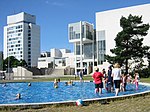Espoo Metro Areena
1999 establishments in FinlandBasketball venues in FinlandBuildings and structures in EspooIndoor arenas in FinlandIndoor ice hockey venues in Finland ... and 3 more
Kiekko-EspooSport in EspooSports venues completed in 1999

Espoo Metro Areena (known from 1999 to January 2009 as LänsiAuto Areena, and from 2009 to October 2015 as Barona Areena) is an arena in the Tapiola District of Espoo, Finland. The arena is sponsored by Hesburger, Finland's largest fast food hamburger chain and is part of the Tapiolan Urheilupuisto (Tapiola Sports Park). It was inaugurated in 1999 and holds 6,982 people for ice-hockey games or up to 8,000 for concerts.
Excerpt from the Wikipedia article Espoo Metro Areena (License: CC BY-SA 3.0, Authors, Images).Espoo Metro Areena
Urheilupuistontie, Espoo Tapiola (Suur-Tapiola)
Geographical coordinates (GPS) Address External links Nearby Places Show on map
Geographical coordinates (GPS)
| Latitude | Longitude |
|---|---|
| N 60.177777777778 ° | E 24.785833333333 ° |
Address
Espoo Metro Areena
Urheilupuistontie 3
02200 Espoo, Tapiola (Suur-Tapiola)
Finland
Open on Google Maps









